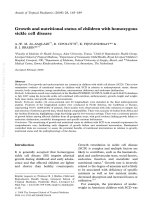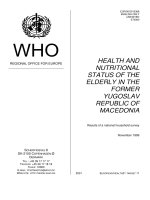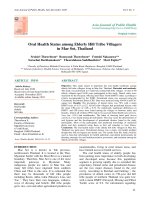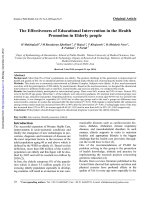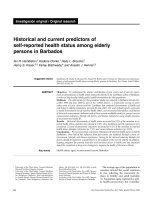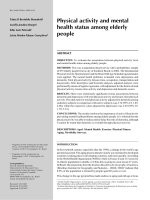Family Support and Health Status of Elderly People: A Case Study of District Gujrat, Pakistan pdf
Bạn đang xem bản rút gọn của tài liệu. Xem và tải ngay bản đầy đủ của tài liệu tại đây (41.85 KB, 7 trang )
Middle-East Journal of Scientific Research 10 (4): 519-525, 2011
ISSN 1990-9233
© IDOSI Publications, 2011
Corresponding Author: Muhammad Shoaib, Department of Sociology, University of Gujrat, Gujrat, Pakistan.
519
Family Support and Health Status of Elderly People:
A Case Study of District Gujrat, Pakistan
Muhammad Shoaib, Sarfraz Khan and Mohsin Hassan Khan
1 1 2
Department of Sociology, University of Gujrat, Gujrat, Pakistan
1
Department of Population Sciences, University of Gujrat, Gujrat, Pakistan
2
Abstract: Present study aims to analyze the impact of family support on the health status of elderly people in
District Gujrat, Pakistan. The proportion of the population of older age group is growing. This growth certainly
continues to the next decades of the present century. Due to the family financial, moral, physical, emotional and
nutritional support most of the elderly people’s mental, physical and social well being is improved significantly.
For the present study, 120 respondents were sampled from four villages of Gujrat. Results of the collected data
showed a positive relation between family support and health status of elderly people in Gujrat. Almost all
sampled elderly people living in rural areas of Gujrat were supported by their family members. Majority of the
respondents were living with and supported by their children and had feeling of belongingness to their families.
Statistical test showed that there was association between family support and health status of elderly people
in Gujrat.
Key words: Family Support % Health Status % Elderly People % Gujrat % Pakistan
INTRODUCTION occurred on a very large scale which ultimately increase
World Population is facing rapid changes in age of the elderly people. Improvement in social conditions
structure. Because of epidemiological and demographic such as education, health facilities, better sanitary
transition, the mortality rates have been declined in the conditions, better living standard, healthy diet and
world. At the same time, because of availability of family development in medical sector played a crucial role in the
planning services and other social conditions fertility increase in life span. Aging is the last phase of human life
rates are also declining. As a result, people are surviving because of social and medical development the time of
more and it is producing elderly people gradually. this period is extending gradually. Many of the social
The world population 60 plus is increasing rapidly. changes of current era have a clear impact on the elderly
Old age is a difficult time for many people, a time of population of developing countries. Due to a severe
declining health, reduced income, the loss of a meaningful change in their lifestyle after retirement, characterized by
role, or the death of loved ones. These problems can sudden decrease or loss of income, poor pension and
create great unhappiness for elder people and can damage other inadequate retirement benefits, and lack of physical
relationships with spouses and children. In extreme cases, work, the elderly are level to develop mental and physical
this damage can lead to mental illness or feeling of stress ailments. Furthermore, their sudden termination from head
[1]. The population aged 60 years and older will increase of the family, which is dictated by his or her earning
in 12 or 13 years by 100 million, equivalent to the status, to a passive participant in decision making, leads
population of a large country [2]. It is expected that by the to lower self-esteem and this led to the neglect of elderly
middle of this century, the proportion of the population by their children and grand children [7].
aged 65 years and older will reach 22 percent in cities and Pakistan is a developing country having a large
26 percent in rural areas [3]. Many studies have number of populations due to decline in mortality rate life
demonstrated that social support has a positive influence expectancy has been greatly increased. This has
on health status of the elderly [4-6]. In developed tremendously affected the aged population in Pakistani
countries social and demographic changes have been society. After the industrial revolution new technology
the life expectancy and it could increase in the proportion
Middle-East J. Sci. Res., 10 (4): 519-525, 2011
520
has been introduced, this improved social and medical but this culture and trend is vanishing rapidly. Due to
conditions. On the other hand due to modernization demographic transition the life expectancy has increased,
several preventative measures that develop, awareness people live longer now. Mostly aged people depend on
not only for those who are elder but also for those who their family and children. Family members support
are at the edge of the old age. This development produces them, look after them and fulfill their all type of needs.
healthy elderly, which are conscious about their health This research will highlight the issue related to elderly
and productiveness for society. Few studies have people and family support to elderly people in rural area
addressed the relationship between social support and of District Gujrat. This study may be helpful for
health status separately for men and women. Family is the researchers to know various kinds of help getting elderly
most important source of financial or social support in towards family. It will also facilitate the forthcoming
most Asian countries. Many studies have confirmed that students, because this study will be the part of library.
family and/or social support improves physical and mental
health [8]. Financial support plays a vital role in health Objectives of the Study:
status of elderly people. Data from many developing
countries in East and South East Asia demonstrate that C To determine the demographic profile of the
most of the elderly persons either co-reside with their respondents.
adult children or receive financial or instrumental support C To explore the level of family support to elderly
from them [9-11]. people.
Elderly may be tortured mentally and psychologically C To analyze the health status of elderly people.
by the continuous blames given by family member or C To find out the association, if any, between family
caregiver. So community treated politely with them and support and health status of elderly people.
fulfills their every need without showing anger or feeling
of unrest to them. Many studies on the relationship MATERIALS AND METHODS
between social support and health status of the elderly
have shown that emotional support may be especially For the present study 120 elderly respondents were
important for the elderly who face a variety of age-related selected through convenience sampling technique.
challenges to their functional ability and health [12, 13]. Because sampling frame of elderly people was not
An efficient and effective primary care to elderly improves available. Elderly people were selected after the informed
their general health status. There is immediate need to consent. Sample was selected from four villages on the
enhance the health care services for the elderly people basis of characteristics like, elderly people having age
so they may improve their health status. Ensure that more than 60 years; belong to rural area; and more
separate medical services for elderly people, separate importantly getting family support. A semi-structured
ward should be established for aged people of the interview schedule was administered by the researchers
country. Mental well-being, emotional satisfaction, which contained different parts like a) the demographic
physically strong and financial well off are associated profile of the respondents; b) level of family support to
with health status of elderly people. All these process elderly people and c) health status of elderly people living
only possible with the help of the family members in in rural area of Gujrat. Further, the data was analyzed by
conjunction with the other institutions. Quality of life is using SPSS version 16.0. Percentage and statistical test
the key component of the health status. was used to draw the conclusion.
The present research deals with the relationship
between nature of support and the health characteristics RESULTS AND DISCUSSION
of elderly. Health disabilities of elderly are usually
associated with the neglect of caregivers, a common type Table No.1.1 presents that 40% elderly people
of mistreatment of elder people. Loneliness and belonged to age group of 66-7, 27.5% had 61-65, 18.3%
depression create a number of problems. There was a time had 71-75 and only 14.2% of the respondents belonged to
when an aged person was respected in our country and age group of 76 and above. Family income is total income
like many traditional societies most of the Pakistani earned by all family members who have been living in the
families still regard their elders as the heads of the family household, including income earned through employment,
and allowed them to be the decision makers. They were business, farming, rent, pensions, dividends, interest,
valuable source of wisdom as they transferred their social security and any other money income. Table no.1.2
experience, values and knowledge to the new generation, shows the family income of the respondents.
Middle-East J. Sci. Res., 10 (4): 519-525, 2011
521
Table1: Demographic Profile of the Respondents
1.1 Age of the Respondents 1.4 Living Arrangements of the Respondents
Categories Frequency Percentage Categories Frequency Percentage
61-65 33 27.5 Separate Room 40 33.3
66-70 48 40.0 Share the Room 63 52.5
71-75 22 18.3 Balcony/Veranda 16 13.3
75 + 17 14.2 No Separate Room 01 0.8
Total 120 100.0 Total 120 100.0
1.2 Family Income of the Respondents 1.5 Number of Children
Categories Frequency Percentage Categories Frequency Percentage
Up to-10000 03 2.5 No Child 06 5.0
10001-15000 17 14.2 Up to 2 07 5.83
15001-20000 27 22.5 3 - 4 31 25.83
20001-25000 27 22.5 5-6 50 41.67
25000+ 46 38.3 7 & Above 26 21.67
Total 120 100.0 Total 120 100.0
1.3 Respondents Supported By 1.6 Living Arrangement Preference
Categories Frequency Percentage Categories Frequency Percentage
Wife 15 12.5 With Family 115 95.8
Son/Daughter 100 83.3 With Friends 02 1.7
Brother/Sister 04 3.3 Separate Room 03 2.5
Social Security Nets 01 0.8 Total 120 100.0
Total 120 100.0
Table 2: Family Support of the Respondents
To Great Extent To Some Extent Not At All Total
Variables f % f % f % f %
Feeling of Belongingness to Family 90 75.0 29 24.2 01 00.8 120 100
Participation in Problems Solving 76 63.3 34 28.3 10 08.3 120 100
Importance of Respondent’s Decision 80 66.7 32 26.7 08 06.7 120 100
Preference of respondent's Decisions 74 61.7 35 29.2 11 09.2 120 100
Family Politely Talk to Respondent 105 87.5 12 10.0 03 02.5 120 100
Leave the Respondent Alone at House 64 53.3 44 36.7 12 10.0 120 100
Feeling of Loneliness 16 13.3 37 30.8 67 55.8 120 100
Fulfillment of Transportation Need 92 76.7 24 20.0 04 03.3 120 100
Fulfillment of Medication Need 101 84.2 19 15.8 00 00.0 120 100
Satisfaction about Family Behavior 91 75.8 22 18.3 07 05.8 120 100
Table 3: Health Status of the Respondents
To Great Extent To Some Extent Not At All Total
Variables f % f % f % f %
Provision of Health Care services on Time 93 77.5 25 20.8 02 01.7 120 100
Look After the Injuries of Respondent 109 90.8 10 8.3 01 0.8 120 100
Facing Weakness by Respondent 18 15.0 68 56.7 34 28.3 120 100
Facing Illness by Respondent 26 21.7 54 45.0 40 33.3 120 100
Facing Sickness due to Improper Nutrition 10 08.3 46 38.3 64 53.3 120 100
Facing Tension while Discussing Issue 18 15.0 39 32.5 63 52.5 120 100
Facing Depression while Decision Making 65 54.2 40 33.3 15 12.5 120 100
Facing the Problems of Sleeplessness 09 7.5 48 40.0 63 52.5 120 100
Facing Eating Problem by Respondent 09 7.5 36 30.0 75 62.5 120 100
Freedom to Attend Social Obligations 65 54.2 38 31.7 17 14.2 120 100
Middle-East J. Sci. Res., 10 (4): 519-525, 2011
522
Table 4: Family Support and Health Status of Elderly People
Family Support
Health Status Low Medium High Total
Low 6 (5.0%) 10 (8.3%) 7 (5.83%) 23 (19.2%)
Medium 1 (0.8%) 10 (8.3%) 35 (29.1%) 46 (38.3%)
High 0 (0.0%) 0 (0.0%) 51 (42.5%) 51 (42.5%)
Total 7 (5.8%) 20 (16.67%) 93 (77.5%) 120 (100%)
Table 5: Fisher’s Exact Test
Value df Asymp. Sig. (2-sided) Exact Sig. (2-sided) Exact Sig. (1-sided) Point Probability
Fisher's Exact Test 46.456 .000
N of Valid Cases 120
a. 4 cells (44.4%) have expected count less than 5. The minimum expected count is 1.34.
b. The standardized statistic is 6.418.
Table 6: Kendall's tau-b Statistical Test
Symmetric Measures
Value Asymp. Std. Error Approx. T Approx. Sig. Exact Sig.
a b
Ordinal by Ordinal Kendall's tau-b .548 .051 6.792 .000 .000
N of Valid Cases 120
a. Not assuming the null hypothesis.
b. Using the asymptotic standard error assuming the null hypothesis.
According to this table 38.3% had 25001+ family income, respondents. According to cited data 41.67% respondents
22.5% respondents had 20001-25000, 22.5% respondents had 5-6 children, 25.83% respondents had 3-4 and 21.67%
had 15001-20000 family income, while only 2.5% respondents had 7 & above children while only 5.0%
respondents had up to 10000 family income. respondents had no children.
Table No.1.3 presents the persons who supported Table No.1.6 presents the prefer living arrangement
the respondents. 83.3% respondents were supported by by respondents. 95.8% respondents wanted to live with
their sons/daughters, 12.5% respondents were supported their family, 2.5% respondents wanted to live in a separate
by their wives, 3.3% were supported by their room and only 1.7% respondents wanted to live with
brothers/sisters while only 0.8% respondents were friends due to unfavorable or unfriendly behavior of their
supported by social security nets. The findings of this family members. According to the findings of Okumagba
study are similar to the findings of the [14]. His study and Kamla [17] the family still accounts for a large
shows the family is still the major welfare provider for old proportion of the support received by the elderly.
people in rural areas. Although the implementation of this Table No.2 depicts the feeling of belongingness to
role has varied significantly, in different historical periods, family by the respondents. More than half (75.0%) of the
owing to social and economic changes in the rural respondents had to great extent feeling of belongingness
environment, the core functions of the family have to their families, 24.2% respondents had to some extent
remained the same, that is, the provision of welfare for and only 0.8% respondents had not feeling of
dependants, particularly for the aged. belongingness to their families. 63.3% respondents
Table No.1.4 shows the living arrangement of participated to solve household problems, 28.3%
respondents at place of living. 52.5% respondents shared respondents to some extent and only 8.3% respondent did
the room with their family members, 33.3% respondents not participate in household problem solving. Finding
had separate rooms, 13.3% respondent’s living also indicates the importance of respondents’ decision in
arrangements were in balcony/veranda and only 0.8% their families. 66.7% respondent’s decision had
respondent had not separate room. There is a need for importance to great extents to their families, 26.7%
more research on the preferences and attitudes of older respondent’s decision had to some extent and only
people in terms of their living arrangements [15, 16]. 6.7% elderly people decision had no importance in
Table No.1.5 describes the children number of the their families.
Middle-East J. Sci. Res., 10 (4): 519-525, 2011
523
Elderly people decisions are preferred in their members at the time of injuries. 56.7% elderly people were
families. 61.7% respondent’s decision was being preferred facing to some extent weakness, 28.3% respondents were
to great extent, 29.2% respondent’s decision to some not facing any type of weakness while only 15.0%
extent and only 9.2% decisions of elderly people were not respondents were facing to great extent weakness.
preferred in their families. According to presented data in According to the above table, 45.0% respondents
the above table 87.5% family members talked politely to were facing to some extent illness, 33.3% elderly people
great extent with respondent, 10.0% respondent’s family were not facing any type of illness and only 21.7%
talked politely to some extent and only 2.5% respondent’s respondents were facing to great extent illness. 53.3%
family members did not talk to them politely. Families and elderly people were not facing sickness due to improper
children leave their elderly people alone at their homes. nutrition, 38.3% respondents were to some extent while
According to the presented data, 53.3% family members only 8.3% respondents were facing to great extent
especially their children did not leave the respondents sickness due to the improper nutrition. Family support
alone at their homes, 36.7% respondents were leaved and friendship improved the psychological well-being of
alone to some extent and only 10.0% respondents were older people. Family support and friendship were related
leaved alone to great extent at their homes by their family positively significantly to psychological well-being.
members especially their children. Data states that 55.8% It is effective support for family and perceived importance
respondents were not feeling loneliness while living in of friendship were strong predictors of psychological
their families, 30.8% respondents were to some extent and well-being. 52.5% respondents were not facing tension at
only 13.3% respondents had to great feeling of loneliness the time of discussing issues with their family members,
in their families. 32.5% respondents were facing to some extent tension
According to data, 76.7% respondent’s while discussing different issues with their family
transportation need was fulfill at the time of need members and only 15.0% respondents were to great extent
properly, 20.0% respondent’s to some extent while only facing tension while discussing different issues with their
3.3% respondent’s transportation need was not fulfilled family members. 54.2% elderly people were not facing
at their homes at the time of need. 84.2% respondent’s depression at the time of participation at the time of
medication need was being fulfilled to great extent at the decision making at family or household level, 33.3%
time of need, 15.8% respondent’s to some extent and there respondents were to some extent facing depression while
was no any respondent whose medication needs was not participating in decision making issues in their families
fulfilled at the time of needs. Statistics shows that 75.8% and only 12.5% respondents were facing to great extent
respondents were satisfied with their family member’s depression at the time of participation in decision making.
behavior towards them. 18.3% respondents to some Field data describes that there were 52.5% respondents
extent, while only 5.8% respondents were not satisfied who did not faced the problem of sleeplessness, 40.0%
with the behavior of their family members. Family is the elderly people facing to some extent problem of
most important source of financial or social support in sleeplessness while only 7.5% respondents were facing to
most Asian countries. Many studies have confirmed that great extent the problem of sleeplessness. 62.5% elderly
family and/or social support improves physical and mental people were not facing eating problems, 30.0%
health [8]. respondents were to some extent and only 7.5%
Table No. 3 depicts the health status of elderly respondents were facing to great extent eating problems.
people living in the rural area of District Gujrat. According According to the table 3, 54.2% respondents were allowed
to the data, 77.5% respondent’s had provision of health to attend social events to great extent, 31.7% respondents
care services to great extent at the time of need, 20.8% were allowed to some extent while only 14.2% elderly
respondent’s had to some extent while only 1.7% people were not allowed to attend social event.
respondent’s had not the provision of health care Table No.4 presents the family support and health
services on time. Eva and Wong [18] conducted a study status of elderly in rural area of Gujrat. According to the
on health care for elderly people. They estimated the need data more than half (77.5%) respondents were getting
of elderly population for the health care services. high level of support from their family members, 16.67%
Statistics shows that 90.8% respondents were looked after medium and only 5.8% respondents were getting family
by their family members at the time of injuries to great support as compared to others. 42.5% respondents had
extent, 8.3% elderly people to some extent and only 0.8% high level of health status, 38.3% had medium while only
respondents were not looked after by their family 19.2% respondents had low level of health status in rural
Middle-East J. Sci. Res., 10 (4): 519-525, 2011
524
area of Gujrat. The study findings show that there was a 2. Jiang, Z., 2005. Population Aging in China and Public
positive relationship between family support and health Policy. Qiu. Shi., 6: 41-43.
status of elderly people in rural area of Gujrat, Pakistan. 3. Zeng, Y., 2001. The Main Feature of Population
The calculated value of Fisher Exact Test is 46.456 i.e. Aging and Policy Considerations in China. Pop. &
significant. Therefore there is a relationship between Econ., 128: 3-9.
family support and health status of elderly people. Also 4. Liu, X., J. Liang. and S. Gu, 1995. Flows of Social
the calculated value of Kendall’s tau-b statistical test is Support and Health Status among Older Persons in
.548 and the level of significance at 1%. There is a China, Soc. Sci. & Med., 41: 1175-1184.
moderate relationship between family support and health 5. Litwin, H., 1998. Social Network Type and Health
status of elderly people in rural area of Gujrat. Status in a National Sample of Elderly Israelis, Soc.
CONCLUSION 6. Ren, X.S., K. Skinner and A. Lee, 1999. Social
The situation of the elderly people in rural areas is Status: Results from the Veterans Health Study in the
related to family support. Family members support their United States, Soc. Sci. & Med., 48(1): 721-34.
elderly people in a different way like financial, moral, 7. Cox, D. and E. Jimenez, 1990. Achieving Social
physical, emotional and nutritional. Elderly people are still Objectives through Private Transfer, Oxford Journals:
depending on their family members especially on their Econ. & Soc. Sci., 5(2): 205-218.
children. They live with them and are supported by them. 8. Silverstein, M. and V.L. Bengston, 1994. Does
Due to this support their health status is also improved. Intergenerational Social Support Influence the
There mental, physical and social well being is improved Psychological Well-being of Older Parents? The
due to support of family. Finding shows the relationship Contingencies of Declining Health and Widowhood,
of family support and quality of life of the elderly people. Soc. Sci. & Med., 38(7): 943-957.
Mostly families are plying supportive role, majority of 9. Davanzo, J. and A. Chan. 1994. Living arrangements
respondents are satisfied to their living arrangements. of older Malaysians, Demography, 31(1): 95-113.
Medication and other needs are fulfilling by their family 10. Knodel, J. and N. Chayovan, 1997. Family support
members. Respondents are living with their families and and living arrangements of Thai elderly, Asia-Pacific
are supported by their sons. It reveals that families are Pop. J., 12(4): 51-68.
playing a very vital role to support the elderly persons. 11. Mason, K., 1992. Family Change and Support of the
Families support is cause to decrease the level of Elderly in Asia, Asia Pac. Popul., l7: 13-32.
frustration, depression, tension among elderly person. 12. Sugisawa, H., 1994. Social Networks, Social Support
Elderly people are widely recognized as being a valuable and Mortality among Older People in Japan, Jour.
source of information, knowledge, wisdom and experience. Geron. Soc. Sci., 49: 3-13.
Later age is very difficult stage of life. Families and 13. Reinhard, J.P. and R. Blieszner, 2000. Predictors of
children should look after and obey their parents. Perceived Support Quality in Visually Impaired Elder,
They need special care, love and affection. The finding of J. Appl. Geront., 19: 345-362.
the present study is also supported by the findings of 14. Xu, Y., 2001. Family Support for Old People in Rural
Suh [19] that healthier people normally have larger China. S. Pol. & Admin., 35: 307-320.
support networks as they can be more socially active and 15. Kinsella, K.G., 1990. Living Arrangements of the
Li et al. [20] e.g. an increase in instrumental support from Elderly and Social Policy: A Cross-national
children to the elderly is associated with deterioration in Perspective. Center for International Research, staff
the subjective health of older men, financial support paper No. 52. Washington, D. C.: United States
from the elderly to children improves the formers’ Bureau of the Census.
subjective health. 16. Myers, G.C., 1996. Aging and the social sciences:
REFERENCES H. Binstock and Linda K. George, Eds. In Handbook
1. Biswas. P., Z.N. Kabir, J. Nilsson and S. Zamanl, 2006. Academic Press, pp: 1-11.
Dynamics of Health Care Seeking Behaviour of 17. Okumagba, P. and K. Raj, 2011. Family support for
Elderly People in Rural Bangladesh, Bangladesh. Intl. elderly in Delta state of Nigeria, Stud. Home. Comm.
J. Ageing and Later Life, 1(1): 69-89. Sci., 5(1): 21-27.
Sci. & Med., 46: 599-609.
Support, Social Selection and Self-assessed Health
research directions and unresolved issues. In Robert
of Aging and the Social Sciences, San Diego, CA:
Middle-East J. Sci. Res., 10 (4): 519-525, 2011
525
18. Eva, L. and E. Wong, 1997. Health Care for 20. Li, S., L. Song and M.W. Feldman, 2009.
Elderly People. Research and Library Services Intergenerational support and subjective health of
Division, Provisional Legislative Council Secretariat, older people in rural China: A gender-based
Hong Kong. longitudinal study. Austral. J. Age., 28: 81-86.
19. Suh, M.K., 1992. The elderly population in Korea:
Their health status and kin-based social support, K.J.
Popul. & Devel., 21(2): 175-196.
